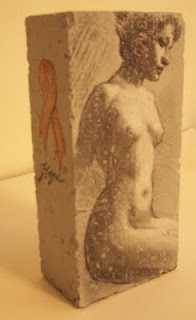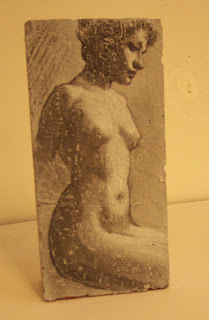
I am trying something a bit different in this post. My "friend" Clem Robins asked if he could do a guest editorial on my blog. It is written in response to one of my posts about my death.
So, just to make things more official:
Any views or opinions expressed in interviews or commentary are those of the guest writer and do not represent the views or opinions of the owner of this blog.
No Praise for the Dead
A Guest Editorial by Clem Robins
Mr. Luschek fancies himself a connoisseur of the fine arts, and writes glowingly about the painters he admires. Metcalf, DeCamp, Sargent, Weiss, Twatchman, Blum, Sisley and others seem to comprise Luschek’s pantheon of artistic merit. He is, of course, welcome to his opinions. Far be it from me to call his taste into question, or his prejudices. But his heroes clearly have just one thing in common, and if no one else has the courage to mention it, I have no choice but to do so myself, and let the chips fall where they may.
To a man, Luschek’s “great masters” are all dead.
Is this mere coincidence? I submit to you that it is not. Along with so many, Mr. Luschek seems to favor the dead over the living. In so doing he falls victim to a cultural prejudice which is rampant in the western world.
Call me an iconoclast, but I don’t like dead people. At the root of every tragedy in world history, you’ll find them at the helm. Hitler is dead. Atilla the Hun is dead. Saddam Hussein is dead. The apologists for the dead would have you believe that this is mere coincidence. It is my hope that they have underestimated the living. It is my hope that enough of us will take a stand.
Perhaps you have never given much thought to how completely the dead have taken over this nation. Please permit me to offer a few facts, which can be verified to your own satisfaction if you are willing to take the time. Believe me, their influence in all spheres of culture is as nefarious as it is widespread.
For example, exactly how much of our current economic malaise can be traced to the dead is an open question, but it’s clear that the dead laid the foundation for it. For example, many left-of-center pundits believe that rampant free market capitalism brought about the housing bubble and subsequent calamity; few of these are willing to note that the proponents of this system, from Adam Smith and de Tocqueville to William F. Buckley and Milton Freeman, are all dead. Other experts blame drastic government intrusion into the markets for the downturn, but they seem timid about mentioning that the architects of such intervention — Engals, Keynes, Veblein, Galbraith and on and on, ad nauseum, are just as dead as their supposed arch enemies. No matter how you look at it, if times are tight, you can blame the dead. Their culpability takes more concrete forms, as well. In a time of urban sprawl, the dead insist upon residing in the choicest open land in America’s cities, and in so doing drive up real estate prices to stratospheric levels.
Jittery about socialized health care? Perhaps you should take up the issue with the seven-term Senator who championed the cause for decades. Oh, wait. You can’t talk to him. He’s dead.
As obvious as these points may seem, just try and espouse them and see how far you get. The major media refuses to permit an honest airing of these ideas, and this should be no surprise. Adolph Ochs, Henry Luce, David Sarnoff, Bill Paley and others who built the print, radio and television empires which engineer what passes for news reporting in America, are all dead. In a nation whose Constitution enshrines freedom of speech as an unalienable right, the dead still make sure that the truth about them is ruthlessly suppressed.
Such repression even runs rampant in simple conversation. Expressions like “don’t speak ill of the dead” pass for politeness among people who never stop and consider that these expressions were all authored by dead people. What other protected class in America is given such immunity from criticism?
For my part, although mine may be a voice crying in the wilderness, I will not hesitate to speak ill of them. It takes courage to do so, but perhaps if enough courageous voices are heard, the dead can be defeated. All it takes for the dead to triumph is for living men to do nothing.
The dead ask much, and give little or nothing in return. They pay no income taxes. They produce no goods or services. And at a point in their existence when they have much wisdom born of experience to offer the rest of us, they remain curiously silent. Perhaps they are simply content to stand by while the civilization they have built is reduced to shambles.
Prejudice is prejudice, no matter how sanitized its image. Why do the dead get a pass from simple rules of honesty or courtesy? Why are the few fearless champions of sanity, such as myself, written off as crackpots, or called names, as if the cry of “necrophobe” is sufficient to end all debate?
As the 2010 elections approach, I urge all patriotic Americans to grill the candidates on their positions regarding the dead. This is a strictly nonpartisan issue. Remember, all the major political parties were founded by dead people. If we, and our elected representatives, can’t muster the courage to stand up to the dead, the time will soon come when we will all join them. The issue is that critical, and the time is now. In the words of Patrick Henry, “Give me liberty, and repeal all special privileges for the dead!”
Yes, let Luschek ramble on about his idols, but one thing is for sure: when a Chase or a Garber is sold, neither man is asked to surrender fifty percent of the purchase price to a gallery owner, like the rest of us.
Think about it.
Clem Robins is a Cincinnati based illustrator. His book “The Art of Figure Drawing” was published in 2002 by North Light Books, has been translated into Chinese, Spanish, French and German, and it is one of the few how-to books on the subject not authored by a dead man. When you purchase your copy, please be assured that not one penny of the royalties will go to the dead.













































